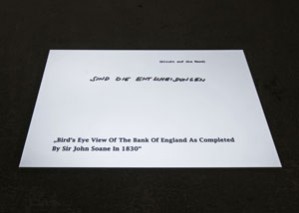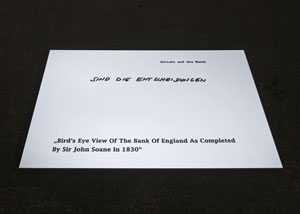
| In the ancient Indian gamble of snakes and ladders, both of the mentioned elements are crucial for the structure of the simple board game, but also quite literally play out the back and forth in time and space representing the twists of fate, as Salman Rushdie interprets it aptly in his book Midnight’s Children .
To find the relating drawings in Tina Schulz’s first solo show at the KOW Gallery in Berlin Mitte one first has to climb down two levels of spiraling steps towards the lower level of the showroom. Exactly this movement becomes the element of another work, a video loop, that abstracts in strictly textual animation a visitor’s tour through the exhibition space as the ‘Description of a temporal relation of two points on a circle’ – the movement From A to B and Back Again to A. Layers [of] past and future, capturing us in spatiotemporal loops of perception, apprehending our sense of time in circular inferences (see also Interview with N. Luhmann ) are reoccurring elements in Tina Schulz‘ works. |
|
|
Most obvious becomes this in another video loop ‚Das Grundgerüst/The Base Frame‘ which again uses text and the reference to a Joseph Michael Gandy drawing from 1830, a bird’s-eye view of the Bank of England’s new building. Within one projection the animation weaves together independently changing descriptions of spatial movements, references to system theory as stated by N.Luhmann „.. the process of observation produces, what will be observed.†and those close to Maturana/Varela , definitions near the concepts of autopoiesis as in “… decisions produce what one sees.†This all is combined with lines that might call up the imagination of an image, showing the new building of the Bank of England as a ruin – again past and future go hand in hand – deciphering the system of finance as a systemic way of communication. |
 |
|
Strapping things down to their very basic concept, like the artist does within her reduced video versions, but also with the cubic wooden shapes which imitate the architectorial forms of the upper exhibition space, where entrance and exit fall together, to which one returns after a detour down to the galleries lower levels, allows the performative nature of perception to become obvious as a circular movement. Reality is an imagination that incessantly reaches forward and backward within spatiotemporal coordinates. The moment is recollection and projection. (from exhibition leaflet) The show of the 1975 Munich born artist deals with a general thrownness of the observer within the concepts of time and space. Circular repetitions define the movements within these. We have to see ourselves as figures whose only security can be found in accepting this definition, which then finally may allow to grasp insights on the recurring. Eventually this defines quite a step. Tina Schulz, KOW Berlin, Germany |
|
